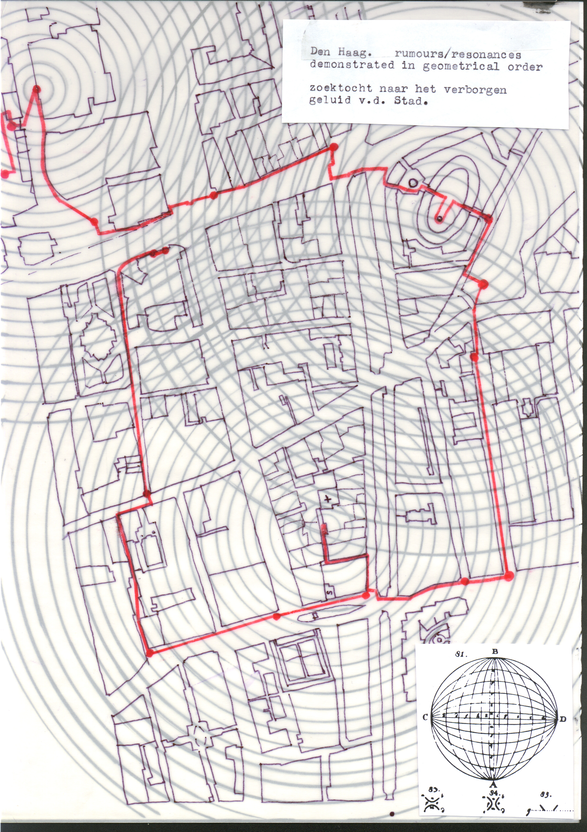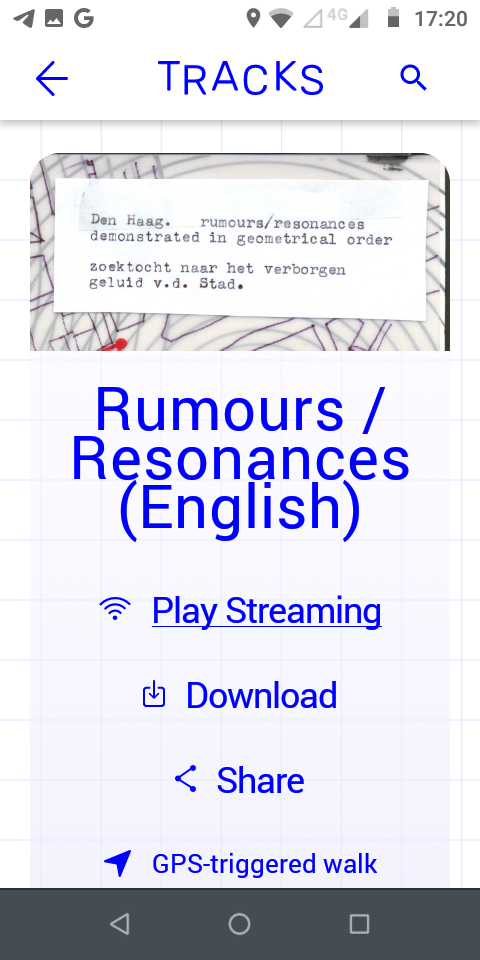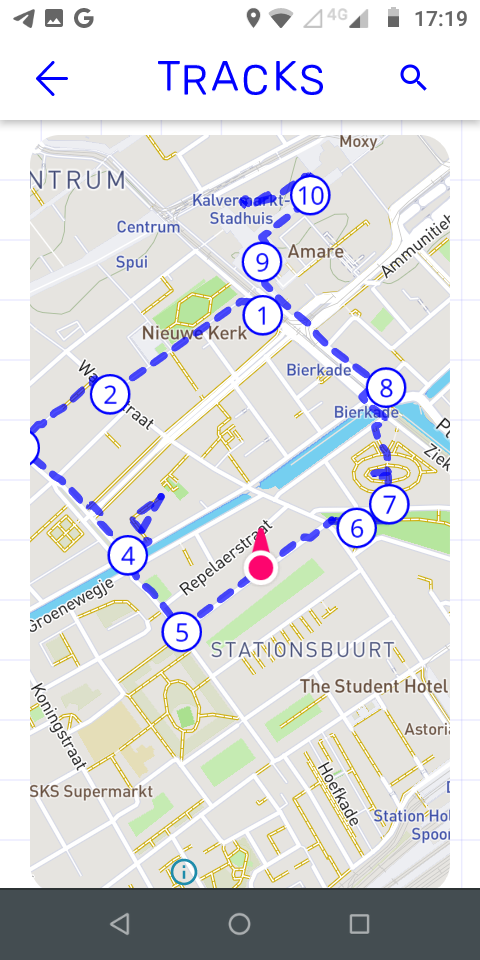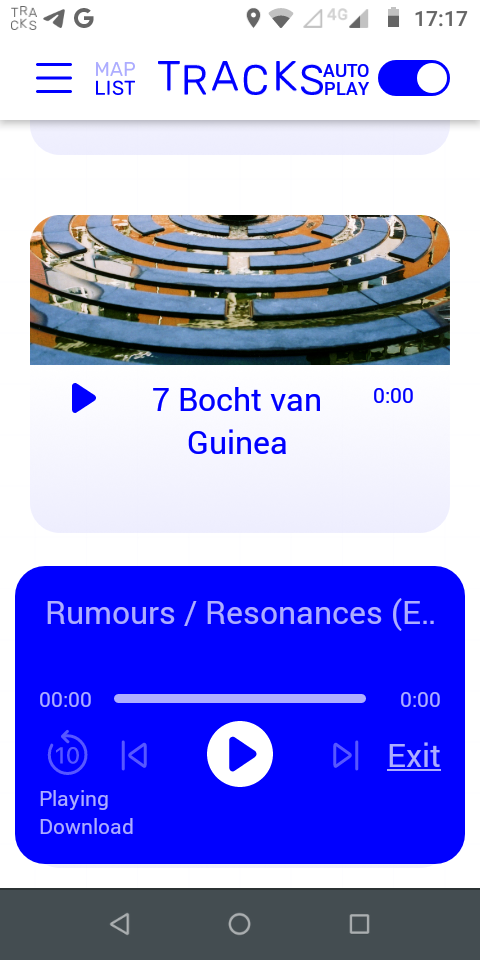During this process, discovering that I had more of the original material than I had thought, and having the device of the "metavoice" I realised that it would not be too much work to make an English version. I had already translated the text. For the metavoice I chose a female voice with a Scottish accent. In the end I was able to reconstruct the whole piece, keeping the timing the same as the Dutch version even though some parts are not identical.
While working on the English version I realised that the new mixes I was making sounded "better" than the original which is something that I didn't expect. I suspect that the tracks on the CD of the Dutch version had been filtered to suit the headphones that were used in the first presentation. Possibly the fact that I am now using current, more advanced software for mixing and editing may play a role as it allows greater signal-to-noise ratios when mixing and mastering. Although it's a shame that it shows that some of the sonic impact has been lost in the original Dutch version, I think that the English version now sounds really good. All this has taught me all over again the importance of making good backups and documentation of projects!
Another aspect of the reactivation is the change from the medium of the CD, where the listener is in charge of starting new episodes at the correct place or moment and Tracks, where sounds can be triggered at particular locations. At first I just located the original soundfiles at the correct start point on the map, set them to play once and all the way to the end when triggered and tested it. In fact this didn't really work very well. The GPS technology used by Tracks to determine location requires the receiver (the telephone) to "see" the satellites transmitting the signal. Tall buildings reflect the signal and can cause the location to be inaccurate. For instance, the starting point outside the Filmhuis was impossible to "find" simply using GPS. There is a tall hotel building opposite which appears to reflect the GPS signal, making the software locate the listener inside the hotel itself. Turning on WiFi, which usually helps to sharpen the spatial resolution, made the location even more unstable unless you are inside the Filmhuis itself. So I had to move the start point. Different phones, with different operating software can give different results so it is important to define location areas that are large enough to absorb these inaccuracies - or choose trigger points that are clear: in the middle of a wide square or street, in a park, away from tall buildings, GPS can be very accurate. In a residential street with lower buildings, when using WiFi as well, location can be accurate to the house number.
Another "problem" with GPS is that it does not work accurately inside buildings. I was a bit worried about the last two episodes of the piece. The walk takes you down into a parking garage under the town hall, and then up again into the atrium, where the next track should be played. Using just GPS, to my suprise, the last track worked perfectly: coming up the stairs from the parking garage suddenly exposed the phone to the GPS signal and the next sound was triggered. However, when I turned WiFi on, (which is necessary for locating the start of the walk) it triggered the sound in the Atrium much too early. So I decided to edit this, and other episodes, together into longer pieces which meant I needed to work more on the instructions to get the timing right.
The result is then a kind of hybrid walk - both relying on instructions AND locative triggering.
Tracks also provides a visual map, making it possible to show the route, which also helps the listener to navigate. The original walk used a booklet with maps, images and notes. This is not really possible to incorporate into the new version, although I have used some visual details from the booklet in the app as each location can also have an image associated with it. Because all the instructions are included in the audio it is possible to experience the piece without looking at the telephone at all. At the moment of writing I have only tested it myself so I am curious how users of other kinds of telephones and people who do not know the route fare with the new version.
As of now, Rumours / Resonances is available in Tracks in Dutch and English versions. The starting point is just inside the Filmhuis, Spui, Den Haag and it takes about 1 hour to complete the walk. It is recommended to download all the audio first, to avoid bandwidth problems and internet roaming costs.
Case Study: Updating the audio walk Rumours / Resonances for the locative media app TRACKS.
The audio walk Rumours / Resonances was originally made for the city arts centre Stroom Den Haag. Their building which was the startpoint of the walk now belongs to the Filmhuis cinema. The piece originally used portable CD players and a map booklet which showed when and where a new track had to be chosen on the player. It has not been available for about 10 years, partly because Stroom discontinued the project and partly because an update was needed in order for it to function properly. So, more than 20 years after it was made, it seemed a good time to use it as a test case for updating and converting into a piece within Tracks.
The centre of Den Haag has changed a lot since the piece was created in 2001, with some buildings having been demolished and others inaccessible due to security regulations. Even so, I realised that it was possible to get around most of these problems by short interventions in the narrative.
Rather than re-record my own voice, which I realise has also changed quite a lot in the past 20 years, I decided to use a different voice which could give a "meta" perspective. In the more recent audiowalk Multiplicity in Brussels, I used the device of having two computer generated voices which "translated" my directions into French and Flemish and I decided to use a similar technique. As I wanted the voice here to be very different from my own, I chose a female voice. As the Dutch voices available were limited I chose again a voice with a Belgian accent. Now both voices, the narrator and the "meta narrator" are outsiders in Den Haag which I think works well.
I also decided, rather than having the metavoice speak "dry" explanations and instructions, to have her inhabit the same paranoid and humorous atmosphere of the original piece. The metavoice warns that the guide is untrustworthy and adds comments about the new architecture. She even "cancels" an episode because it is not suitable for the sensibilities of contemporary listeners (in reality I had to remove it because in the current situation, navigation was very difficult.)
One of the problems was that the original files used for mixing and editing the piece had been lost - meaning that it was almost impossible to simply erase a voice and replace it with another. I had to work with the "finished" mixes themselves. Luckily I was able to still trace the original recordings of the environmental sounds used, as well as some of the composed material as separate files without voice. That made it easier to change transitions and fill in gaps.



